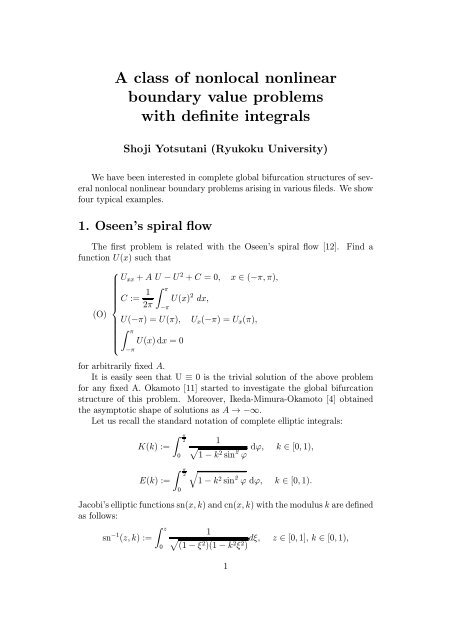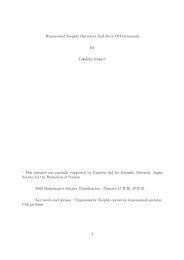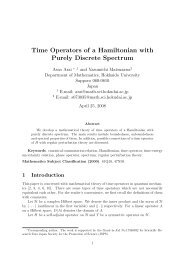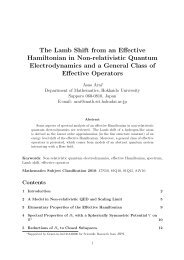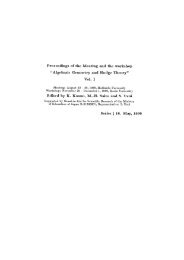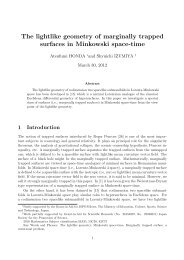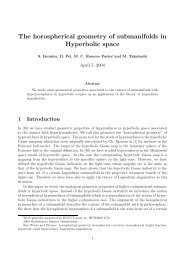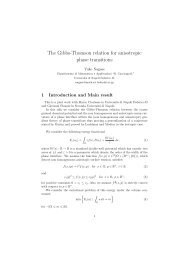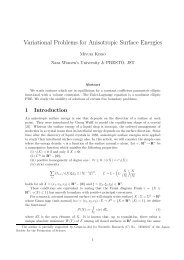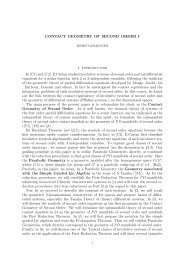A class of nonlocal nonlinear boundary value problems with definite ...
A class of nonlocal nonlinear boundary value problems with definite ...
A class of nonlocal nonlinear boundary value problems with definite ...
Create successful ePaper yourself
Turn your PDF publications into a flip-book with our unique Google optimized e-Paper software.
A <strong>class</strong> <strong>of</strong> <strong>nonlocal</strong> <strong>nonlinear</strong><br />
<strong>boundary</strong> <strong>value</strong> <strong>problems</strong><br />
<strong>with</strong> <strong>definite</strong> integrals<br />
Shoji Yotsutani (Ryukoku University)<br />
We have been interested in complete global bifurcation structures <strong>of</strong> several<br />
<strong>nonlocal</strong> <strong>nonlinear</strong> <strong>boundary</strong> <strong>problems</strong> arising in various fileds. We show<br />
four typical examples.<br />
1. Oseen’s spiral flow<br />
The first problem is related <strong>with</strong> the Oseen’s spiral flow [12]. Find a<br />
function U(x) such that<br />
(O)<br />
⎧<br />
Uxx + AU− U<br />
⎪⎨<br />
⎪⎩<br />
2 + C =0,<br />
C :=<br />
x ∈ (−π, π),<br />
1<br />
Z π<br />
U(x)<br />
2π −π<br />
2 dx,<br />
U(−π) =U(π),<br />
Z π<br />
U(x)dx =0<br />
Ux(−π) =Ux(π),<br />
−π<br />
for arbitrarily fixed A.<br />
It is easily seen that U ≡ 0 is the trivial solution <strong>of</strong> the above problem<br />
for any fixed A. Okamoto [11] started to investigate the global bifurcation<br />
structure <strong>of</strong> this problem. Moreover, Ikeda-Mimura-Okamoto [4] obtained<br />
the asymptotic shape <strong>of</strong> solutions as A →−∞.<br />
Let us recall the standard notation <strong>of</strong> complete elliptic integrals:<br />
K(k) :=<br />
E(k) :=<br />
Z π<br />
2<br />
0<br />
Z π<br />
2<br />
0<br />
1<br />
p 1 − k 2 sin 2 ϕ dϕ, k ∈ [0, 1),<br />
q<br />
1 − k 2 sin 2 ϕ dϕ, k ∈ [0, 1).<br />
Jacobi’s elliptic functions sn(x, k)andcn(x, k) <strong>with</strong> the modulus k are defined<br />
as follows:<br />
sn −1 Z z<br />
1<br />
(z,k) := p dξ, z ∈ [0, 1], k∈ [0, 1),<br />
(1 − ξ2 )(1 − k2ξ 2 )<br />
0<br />
1
and<br />
We note that<br />
cn 2 (z, k) =1− sn 2 (z,k).<br />
E(0) = K(0) = π<br />
1<br />
, E(1) = 1, K(k) ∼<br />
2 2 log<br />
µ<br />
16<br />
1 − k2 <br />
as k → 1.<br />
Ikeda-Kondo-Okamoto-Yotsutani [3] have parameterized all solutions (A, U)<br />
<strong>of</strong> (O) in terms <strong>of</strong> the elliptic functions, and clarified the global bifurcation<br />
structure by the following Theorems 1 and 2.<br />
Theorem 1 All the solution (A, U) <strong>of</strong> (O) are parameterized by<br />
where<br />
{(n 2 A(k),n 2 U(nx − x0; A(k)) : 0
The structure <strong>of</strong> solutions is similar to that <strong>of</strong> Oseen’s spiral flow, though<br />
the analysis is more difficult. Kosugi-Morita-Yotsutani [5] have clarified<br />
the global bifurcation structure <strong>of</strong> this problem. (See, also Kosugi-Morita-<br />
Yotsutani [6].)<br />
We briefly explain about the original equation. Consider the following<br />
Ginzburg-Landau equation:<br />
½<br />
ψxx + λ(1 − |ψ| 2 )ψ =0, x ∈ (−π, π)<br />
ψ(−π) =ψ(π), ψx(−π) =ψx(π).<br />
We here assume that |ψ| > 0andψ is written as the form<br />
ψ = u(x)exp(iθ(x)),<br />
where u and θ are both real-<strong>value</strong>d smooth functions. Clearly the equation<br />
is equivalent the following system:<br />
⎧<br />
⎪⎨<br />
⎪⎩<br />
uxx − θx 2 u + λ(1 − u 2 )u =0, x ∈ (−π, π),<br />
(u 2 θx)x =0,x∈ (−π, π),<br />
U(−π) =U(π), Ux(−π) =Ux(π),<br />
θ(π) − θ(−π)u =2mπ, θx(−π) =θx(π),<br />
where m is an integer. Thus, θx = C/u 2 for a constant C and hence we<br />
obtain (P).<br />
3. Minimum energy curve<br />
The third problem is related to find the minimum energy curve for given<br />
the length L and area M, which K.Watanabe [14] started to investigate.<br />
For given L>0andM>0<strong>with</strong>L2−4πM >0, find a function κ(s)<br />
such that<br />
⎧ ©<br />
κss +<br />
⎪⎨<br />
(E)<br />
⎪⎩<br />
1<br />
2κ3 + μκ ª<br />
=0,s∈ [0,L],<br />
s<br />
1 μ := L2 n<br />
M −4πM<br />
R L<br />
0 κ(s)3ds − L<br />
R L<br />
2 0 κ(s)2 o<br />
ds ,<br />
κ(0) = κ(L), κs(0) = κs(L),<br />
κ(s)ds =2π.<br />
R L<br />
0<br />
Murai-Matsumoto-Yotsutani [10] have clarified the global bifurcation strucure<br />
<strong>of</strong> this problem, though terribly complicated calculations are needed.<br />
3
4. Cross-diffusion<br />
The final problem is a limiting equation for the Shigesada-Kawasaki-<br />
Teramoto model <strong>with</strong> cross-diffusion [13]. This problem is the hardest.<br />
Find (v(x), τ) such that τ > 0, and<br />
⎧ Z 1 µ<br />
<br />
τ<br />
τ<br />
a1 − b1 − c1v(x) dx =0,<br />
⎪⎨ 0 v(x) ³ v(x)<br />
τ<br />
´<br />
(C) d2vxx + v · a2 − b2 − c2v =0 in(0, 1),<br />
v<br />
⎪⎩<br />
vx(0) = 0, vx(1) = 0,<br />
v>0 on [0, 1].<br />
where a1,a2,b1,b2,c1,c2,d2 are given positive constants.<br />
We briefly explain the original equation. In 1979, Kawasaki—Shigesada—<br />
Teramoto proposed a cross-diffusion system<br />
⎧<br />
⎪⎨<br />
⎪⎩<br />
ut = {(d1 + ρ12v)u} xx + u(a1 − b1u − c1v) (0
Conjecture 1: Suppose that B
Conjecture 3: Suppose that C>7B/3. There exists the only one<br />
connected non-empty open set D such that (S) has exactly two solutions<br />
(v(x), τ) if and only if d2 ∈ D.<br />
Stability:<br />
C>7B/3, a2 = b2 = c2 =1<br />
C>7B/3, a2 = b2 = c2 =1<br />
Lou-Ni-Yotsutani [8] have almost clarified the existence and the shape <strong>of</strong><br />
solutionsasfollows.<br />
6
Theorem 3 (Existence) Suppose that B
Theorem 6 (Shape <strong>of</strong> solutions as d2 → 0 for A < (B +3C)/4) Let<br />
(v(x, d2), τ(d2)) be solutions <strong>of</strong> (S). IfA0,<br />
C − B<br />
τ(d2)<br />
v(0; d2)<br />
τ(d2)<br />
v(x; d2)<br />
a2<br />
→ ·<br />
2c2<br />
C − A<br />
C − B<br />
→ a2<br />
b2<br />
· C − A<br />
A − B<br />
·<br />
− A,<br />
B+3C<br />
4<br />
for x>0,<br />
C − B<br />
Theorem 7 (Shape <strong>of</strong> solutions as d2 → 0 for A ≥ (B +3C)/4) Let<br />
(v(x, d2), τ(d2)) be solutions <strong>of</strong> (S). IfB0,<br />
for x>0,
Now, we will discuss about the uniqueness and non-uniquess. The following<br />
result are a part <strong>of</strong> joint projects <strong>with</strong> W.-M. Ni.<br />
Theorem 8 Suppose that B7B/3. There exists an open set D such that<br />
(S) has at least two solutions (v(x), τ) for d2 ∈ D.<br />
References<br />
[1] Y.S. Choi, R. Lui and Y. Yamada, Existence <strong>of</strong> global solutions for<br />
Shigesada-Kawasaki-Teramotomodel <strong>with</strong> weak cross-diffusion, Discrete<br />
Contin. Dyn. Syst. 9 (2003), 1193-1200.<br />
[2] Y.S. Choi, R. Lui and Y. Yamada, Existence <strong>of</strong> global solutions<br />
for Shigesada-Kawasaki-Teramotomodel <strong>with</strong> strongly coupled crossdiffusion,<br />
Discrete Contin. Dyn. Syst. 10 (2004), 719-730.<br />
[3] H. Ikeda, K. Kondo, H. Okamoto and S. Yotsutani, On the global<br />
branches <strong>of</strong> the solutions to a <strong>nonlocal</strong> <strong>boundary</strong>-<strong>value</strong> problem arising in<br />
Oseen’s spriral flows, Commun. Pure Appl. Anal., 3 (2003), 381-390.<br />
[4] H. Ikeda, M. Mimura and H. Okamoto, A Singular perturbation problem<br />
arising in Oseen’s spiralflows, Japan J. Indust. Appl. Math. 18 (2001),<br />
393-403.<br />
9
[5] S. Kosugi, Y. Morita and S. Yotsutani, A complete bifurcation diagram<br />
<strong>of</strong> the Ginzburg-Landau equation <strong>with</strong> periodic <strong>boundary</strong> condition, Commun.<br />
Pure Appl. Anal., 4 (2005), no.3, 665-682.<br />
[6] S. Kosugi, Y. Morita and S. Yotsutani, Global bifurcation structure<br />
<strong>of</strong> a 1-d Ginzburg-Landau model, Journal <strong>of</strong> Mathematical Physics, 46<br />
095111 (2005), no.1, 1-24.<br />
[7] Y. Lou and W.-M. Ni, Diffusion vs. cross-diffusion: An elliptic approach,<br />
J. Differential Equations 154 (1999), 157-190.<br />
[8] Y.Lou,W.-M.NiandS.Yotsutani,On a limiting system in the Lotka—<br />
Volteracompetition <strong>with</strong> cross-diffusion, Discrete Contin. Dyn. Syst. 10<br />
(2004), 435-458.<br />
[9] M. Mimura, Y. Nishiura, A. Tesei and T. Tsujikawa, Coexistence problem<br />
for two competing species models<strong>with</strong> density-dependent diffusion,<br />
Hiroshima Math. J. (1984), 425-449.<br />
[10] W. Matsumoto, M. Murai and S. Yotsutani,What have we leared on the<br />
problem: Can one hear the shape <strong>of</strong> a drum ?, PHASE SPACE ANAL-<br />
YSIS OF PARTIAL DIFFERENTIAL EQUATIONS, Vol.II, PUBBLI-<br />
CAZIONI DEL CENTRO DI RICERCA MATEMATICA ENNIO DE<br />
GIORGI.<br />
[11] H. Okamoto, Localization <strong>of</strong> singularities in inviscid limit — numerical examples,<br />
Proceedings <strong>of</strong> Navier-Stokes Equations: Theory and Numerical<br />
Methods (ed. R. Salvi), Longman, Pitman Reserch Notes in Methamatics<br />
Series 388 (1998), 220-236.<br />
[12] C. W. Oseen, Exakteösungen der hydrodynamischenDifferentialgleichungen.<br />
I., Arkiv Mat. Astr. Fysik, 20 (1927—1928), No. 14, pp. 1-14: ibid.<br />
II., ibid, No. 22, 1—9.<br />
[13] N. Shigesada, K. Kawasaki and E. Teramoto, Spatial segregation <strong>of</strong> interacting<br />
species, J. Theoretical Biology 79 (1979), 83-99.<br />
[14] K. Watanabe, Plane domains which are spectrally determined, Ann.<br />
Global. Anal. Geom. 18 (2000), 447-475.<br />
10


